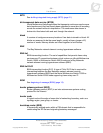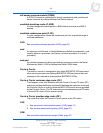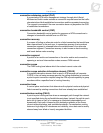
- 27 -
List of terms
Nortel Multiservice Switch 7400/15000/20000
Terminology
NN10600-005 7.2S1 Standard
PCR7.2 and up March 2006
Copyright © 2006, Nortel Nortel Confidential
cell switching
A hardware-based switching technology in which data entering the network is
broken down into one or more fixed-length cells. The cells are transported
independently through the network and reassembled at the destination.
cell transfer delay (CTD)
The time it takes a cell to travel from one end of a virtual connection to the
other. CTD is also defined as the measurable elapsed time between an exit
event at a measuring point (the source UNI) and an entry event at a measuring
point (the destination UNI). This measurement is the sum of the total inter-
node transmission delay and the total node processing delay between the two
measuring points.
central processing unit (CPU)
The main processing unit of a device that performs program sequencing and
arithmetic logic.
CES
See circuit emulation service (CES) (page 28).
channel
The smallest subdivision of a circuit that provides a single type of
communication service.
channel-associated signaling (CAS)
Signaling used in voice or modem connections in which specific bits in the
DS1 or E1 frame structure carry the ABCD signaling information for each
channel.
channel service unit (CSU)
A type of interface used to connect a terminal or computer to a digital medium.
A CSU also performs diagnostic and protective functions, such as providing a
keep-alive signal to maintain line synchronization.
child node
In an ATM PNNI network, a node at the next lower level of the hierarchy where
that node is contained in the peer group represented by the logical group node
currently referenced. The child node can be a logical group node or a physical
node.
child peer group
A child peer group of a peer group is any one group that contains a child node
of a logical group node in that peer group.
CID
See customer identifier (CID) (page 38).


















